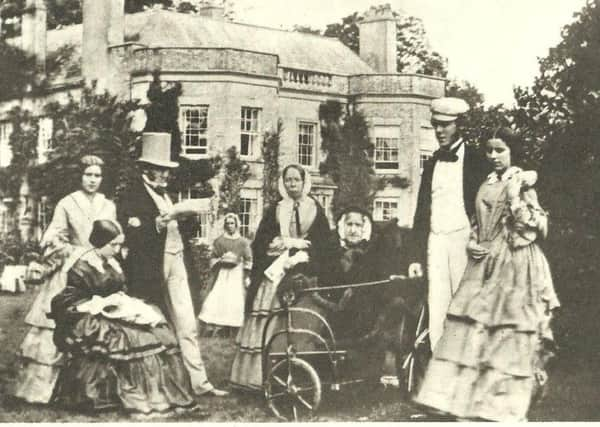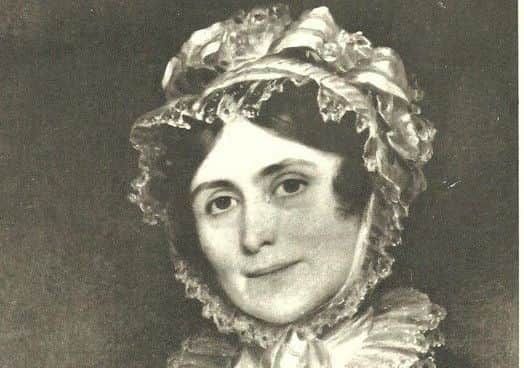Heritage: The wonder women of Wincobank Hall


Mary Anne Rawson died in 1887 and left an extraordinary legacy at home and abroad.
Widowed at an early age, her only child pre-deceased her and she left no descendants – but still the reach of her campaigning work for social reform at home and abroad stretched far into the future.


Advertisement
Hide AdAdvertisement
Hide AdShe was married in 1827 to William Bacon Rawson from Nottingham but two years later returned to her family home, a desolate widow with a small child.
She never remarried but threw herself into many philanthropic projects.
She composed poems and wrote leaflets in support of the abolition of slavery and, by persuasive letter-writing to the celebrities of the day, collated a unique anthology of prose and poetry entitled The Bow in the Cloud, using the Biblical image that symbolises hope and God’s promise of a better world to come.
An original copy of this book, along with all the supporting letters and drafts, is held at Manchester Rylands Library and can be seen by arrangement.


Advertisement
Hide AdAdvertisement
Hide AdShe continued campaigning long after 1833 when the Government abolished slavery in the colonies, protesting about a seven-year ‘apprenticeship’ for slaves which meant they were forced to continue working for the same people who may have cruelly mistreated them.
In 1840 she attended the International Convention for the Universal Abolition of Slavery, an organisation better known today as Anti-Slavery International.
In 1875, at the age of 74, she was still vociferously objecting to the British Navy returning runaway slaves to their home countries.
She took a keen interest in education, particularly for girls. With her daughter Lizzie, she established the first Free Bible school in Turin, Italy, where pupils could study the Bible in their home language rather than in Latin as ordered by the Vatican.
Advertisement
Hide AdAdvertisement
Hide AdShe continued to take an interest in the Italian schools all her life.
She raised funds for one of the first teacher training colleges in the world, the Thompson Normal School in Jamaica, meaning that this would set the norm for all other schools.
At home she donated land and raised funding for the first day school in the Wincobank area and, seeing the social harm caused by alcohol abuse, she signed The Pledge in 1839, becoming one of the earliest teetotallers.
Through contact with families at the little day school and Sunday School at High Wincobank, she worked to persuade workers to drink less to reduce domestic violence and help make the family budget go further.
Advertisement
Hide AdAdvertisement
Hide AdMary Anne was very interested in new ideas and when she formed a trust to ensure the survival of the Sunday school and chapel that her parents had established in the outbuildings of Wincobank Hall, she embedded a clause in the trust deeds to ensure that all worship would be undenominational, without sectarian bias.
This was an idea from America designed to avoid the schisms that created five kinds of Methodism and several forms of Baptists. To this day Upper Wincobank Chapel continues to be uniquely independent, managed by the congregation with the building managed by the charity of Mary Ann Rawson for Wincobank School.
In an age when unmarried girls were under the control of their fathers and married women were quite literally the property of their husbands, Mary Anne was in an unusual position as a widow. Most would have remarried but she chose to say single.
She was quite definitely in the vanguard of the march towards independence for women. But she did not align herself with the Suffragette movement because she felt it would distract from her main causes which were to alleviate suffering by providing opportunities for education and the example of Jesus.
Advertisement
Hide AdAdvertisement
Hide AdAt a time when women were not permitted to speak in a public place, Mary Anne communicated her opinions in writing, circulating her publications until they reached coffee tables of the wives of men of influence.
When she died in 1887, she had used or given away all her wealth and allowed Wincobank Hall to deteriorate to a point at which a buyer could not be found, but the investment she made in the lives of others continues to grow.
The memorial plaque in Upper Wincobank Chapel to Mary Anne’s sister, Emily Read, reads “Daily visitor of these schools for over 40 years, faithful friend and helper of all around, she spent a long life in the labours of love, the remembrance of which is affectionately treasured by her village friends”.
Emily was the teacher in both the day school and the Sunday school for 66 years and often visited local families needing help, encouraging them to keep their faith and trust in God.
Where did this extraordinary spirit come from?
Advertisement
Hide AdAdvertisement
Hide AdHer mother Elizabeth Read, née Smith, was born in 1778, the eldest of 18 children born to Ebenezer and Elizabeth Smith of the Chesterfield Iron Works, only six of whom survived.
Ebenezer had trained to be a non-conformist minister but on the death of his father took over the family business at Griffen Foundry, Brampton. Elizabeth inherited her father’s commitment to the non-conformist ideals of religious freedom and social reform.
After marrying Joseph Read and moving to Wincobank Hall in 1816, Elizabeth and her daughters established a Sunday school for the local children in the coach house. It was Elizabeth’s mission in life that her children would follow her strong Christian faith and develop a sense of social responsibility that would lead not just to words but to actions.
Under their mother’s leadership, the girls became involved with many campaigning organisations, including the Society for Bettering the Conditions of the Poor, the Bible Society and the Lancasterian School Society, which was a progressive system of schooling developed in America, favouring recognition of achievement rather than punishment for shortcomings.
Advertisement
Hide AdAdvertisement
Hide AdIn addition to religious instruction for the children, they promoted cleanliness and domestic order to improve conditions for the whole family. With Mary Anne, she founded the Sheffield Female Anti-Slavery Society and the Sheffield Ladies Association for the Universal Abolition of Slavery.
Elizabeth Read died in 1885 and by her example had founded a dynasty of campaigners who shared her desire to improve conditions for the less fortunate.
Elizabeth’s second daughter, Eliza Read, was two years younger than Mary Anne. She married William Wilson, a cotton spinner from Nottinghamshire, and they had eight children. The day before her child Henry was born Eliza wrote a poem, The Hope of the Slave, and despite poor health tried hard to encourage and comfort the poor.
Her daughter Rebekah wrote of her: “Our lovely mother, ready for every good word and work, not only in her maiden days among the poor, at Attercliffe and Wincobank, but also in her early married life, among the Radford work people, and around any who needed her help or counsel, always thinking not of herself but of others and trying to bring up her children in the nurture and admonition of the Lord, with a tenderness and devotion surpassing all words.”
Advertisement
Hide AdAdvertisement
Hide AdEliza died in 1851 of lung disease, swiftly followed by her eldest daughter Mary and the following year by her son William Cecil.
Elizabeth’s third daughter, Catherine Read, known as Aunt Kate, devoted her life to the care of her sister Eliza and, after her death, to the remaining five children. She lived with the Wilson family in Nottingham until William remarried in 1862 and she returned to Wincobank to care for her mother. Catherine and Elizabeth Read died in the same year.
Another daughter, Sarah, died aged 23 and the youngest child Edmund went on to manage his father’s business, working with his uncle and later with brother-in-law William Wilson to rebrand the business as Sheffield Smelting Works, still trading today.
The Read family and Mary Anne Rawson were buried in the grounds of Zion Chapel Attercliffe, the graveyard of which was recently offered for sale.
The legacy of this family is one of the unsung stories of Sheffield and their graves should be honoured and preserved with public access.